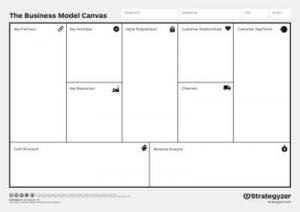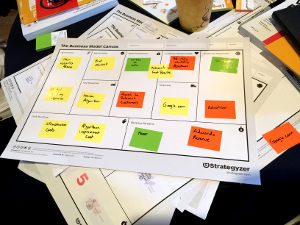Business Model Canvas Overview
We’re going to provide an overview of Strategyzer’s Business Model Canvas in this post. We’ll start by discussing the sections of the canvas then give an example of using the canvas to describe the model for Google Adwords. We’ll finish up with a few tips and talk about different ways to use the canvas. Ok, what are we looking at here?….
What is the Business Model Canvas?
- High Level Diagram showing how a business connects with and provides value to customers and funds its internal operations
- Can be used to identify gaps or weaknesses in the business and then create a strategy to address them
- Create a common language to communicate Strategy between internal teams
- ‘Tell the Story’ of a business: What are the key strengths and activities? What relationships are important?
- Used as a tool for the ideation, discussion, and exploration necessary to drive innovation
- Used as a tool to plan major changes and strategy pivots
- Powerful when combined with a framework for customer-centric positioning and innovation

Sections of the Canvas
When communicating a business model we like to start with the Customer’s Needs, talk about how the business meets those needs, then work our way through the necessary components to support the delivery. We’ll take a look at each segment and then use Google as an example to show how this can tell the story of your business operation.
Customer Segment
Who are your primary customer segments and what are the most important things they need from you? Often this section will just include the primary segments you target. At the strategic level we don’t need to include all of the details that define the segment. This would be better left to the Value Proposition Design and Customer Profile documents.
Value Proposition
What do you do for each segment? List a specific value offered to each segment you’ve listed. The details of the Value Proposition are worked out using the Value Proposition Design canvas. The items you list here should be the most important things you offer your customer.
Channels
How do you connect to the customer? Do you use online channels, face-to-face sales, customer service over the phone? Are there special attributes to the channel that affect the way you connect?
Customer Relationships
This section defines attributes of the relationship you need to form over the channels you use to communicate. Some organizations need a relationship based on a high degree of trust, others on fast turnaround, or tailored service. Describe the most important attributes that describe the relationship here.
Revenue Streams
Now that the customer interaction has been defined, how does the value you deliver convert to revenue? There could be multiple sources of revenue or different types of revenue built into your model. Are your products purchased in one-off transactions, or through recurring subscriptions? Do you sell a product with a maintenance service up-sell? Do you set the price, or negotiate it?
Key Resources
Now we shift to the internal side of the model. What are the key resources or strengths that your business offers that allow it to provide the customers with value? This might include your infrastructure, specialized knowledge, or software and intellectual property.
Key Activities
How do you translate the resources and supply inputs into value? This is where you mention your key operations and list the most important activities that create value for the customer. This might include production operations at a factory, software development at a software company, or logistics at a shipping company.
Cost Structure
Supplying the key resources and completing the activities result in costs to the business. Track the major categories of costs that define the operation of the business. Are labour, material costs, or R&D costs the ones that contribute most?
Key Partners
All businesses operate within a network with key suppliers, delivery partners, or other contributors. Record the most important ones in this section and pay attention to how they connect to the activities and resources you offer.
Google Adwords Example
Google Adwords is a service that helps two customer segments: People Searching and Advertisers. It helps people searching Access Relevant Information, and it helps advertisers Access Relevant Customers. People searching use google.com, and advertisers use adwords.google.com to structure their ads. It is important that Google offers Fast, Relevant Results to people searching. Advertisers Place Bids on keyword clicks, but people searching pay nothing. To offer this service Google required an Intelligent Search Algorithm and Infrastructure. Google’s engineers develop software that matches searches to relevant information. Development incurs a Labour Cost. The Infrastructure has to be Purchased and Maintained. To expand the value of the service Google partners with Other Websites to expand their reach, and Digital Marketing Agencies that use the platform to help their customers advertise.

How Does This Help?
People have been using the Business Model Canvas in a number of ways. We use it to understand a client’s business model during the initial consultation. Later on, we use the model to frame discussions about different aspects of the business that can be improved. This might lead to an innovation program that focuses on a particular aspect of the business, for instance. Strategyzer has seen the model used in many ways. Here are a few that we find interesting:
- Setting Overall Strategic Direction and Focus for Improvements
- Diagram Competitors Business Models to Generate Ideas for Differentiating from Competition
- Mapping the Customer Relationship and Product Distribution System
- New Product / Market Innovation
- Shared Language between departments and lines of business.
Do you want to learn more about using the canvas? Contact Us to walk through your own business model and see how it can be used to uncover opportunities for improved growth and innovation within your own business.
